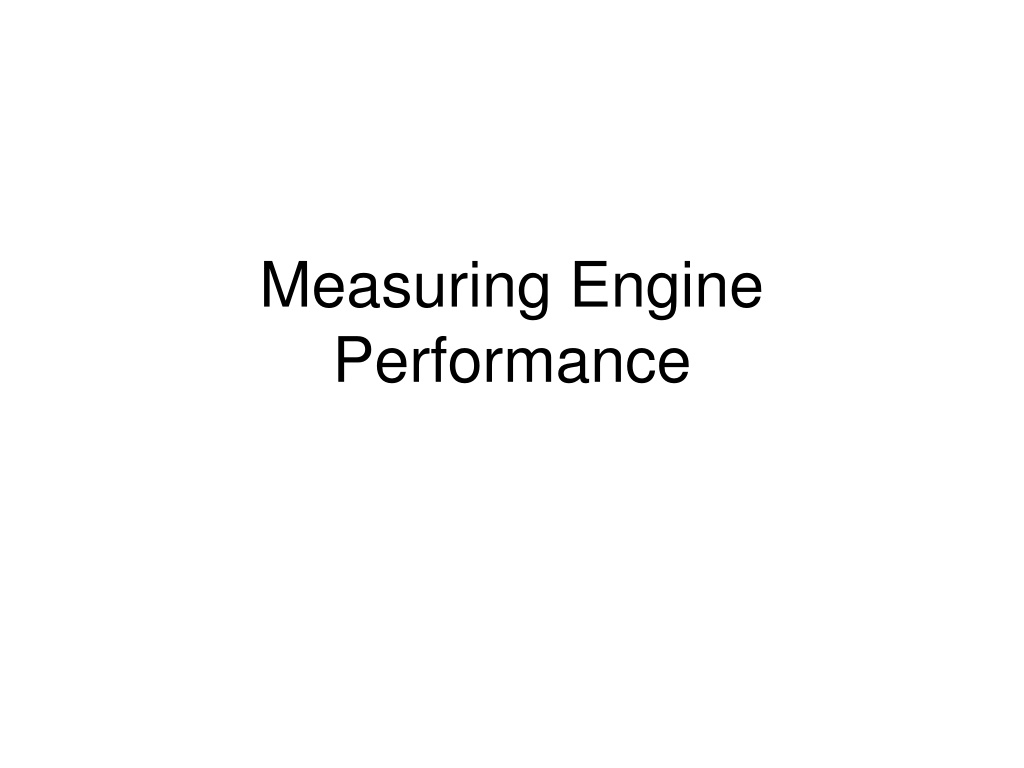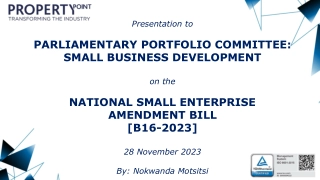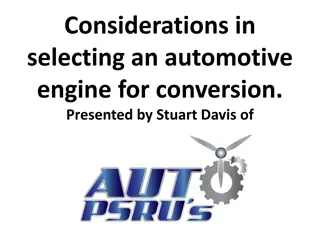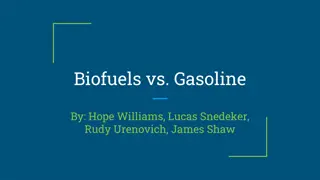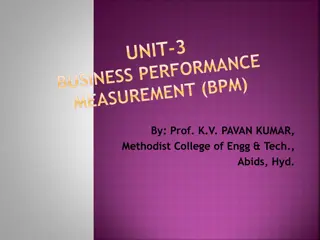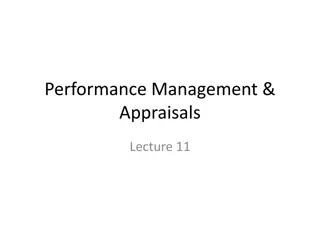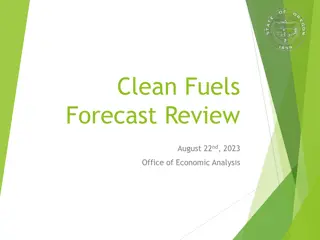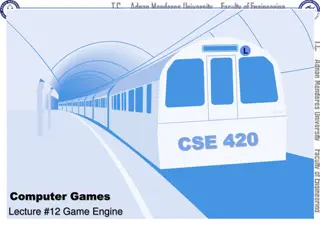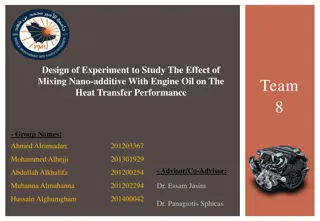Understanding Small Gasoline Engine Performance
This chapter explores the intricacies of measuring and optimizing internal combustion engine performance, focusing on calculating functional horsepower through various formulas and measurements. It delves into the combustion process in a small gasoline engine, detailing how the air/fuel mixture ignites, expands, and drives the piston with the help of inertia. The concept of inertia, a fundamental physical law governing motion, is crucial in understanding the repetitive cycle of the piston within the engine, highlighting the significant stresses it undergoes during operation.
Download Presentation

Please find below an Image/Link to download the presentation.
The content on the website is provided AS IS for your information and personal use only. It may not be sold, licensed, or shared on other websites without obtaining consent from the author. Download presentation by click this link. If you encounter any issues during the download, it is possible that the publisher has removed the file from their server.
E N D
Presentation Transcript
Measuring Engine Performance
The main goal of this chapter is to determine functional horsepower through different measurements and formulas
Small Gasoline Engine Internal Combustion
Small Gasoline Engine Internal Combustion Air/fuel mixture is ignited inside the engine
Small Gasoline Engine Internal Combustion Air/fuel mixture is ignited inside the engine The gasses (when ignited ) expand in all directions
Small Gasoline Engine Internal Combustion Air/fuel mixture is ignited inside the engine The gasses (when ignited ) expand in all directions Only the piston is allowed to move
Small Gasoline Engine Internal Combustion Air/fuel mixture is ignited inside the engine The gasses (when ignited ) expand in all directions Only the piston is allowed to move Inertia
Small Gasoline Engine Internal Combustion Air/fuel mixture is ignited inside the engine The gasses (when ignited ) expand in all directions Only the piston is allowed to move Inertia A physical law that states an object in motion will continue in motion or an object at rest will continue at rest unless an additional force is applied.
Small Gasoline Engine Internal Combustion Air/fuel mixture is ignited inside the engine The gasses (when ignited ) expand in all directions Only the piston is allowed to move Inertia A physical law that states an object in motion will continue in motion or an object at rest will continue at rest unless an additional force is applied. The piston reaches TDC then reverses direction, repeating the process at BDC. This places extreme stress on the engine by changing the inertia
Performance Defined as the work engines do
Performance Defined as the work engines do also, Defined as how well they do the work
Bore The diameter or width across the top of the cylinder Measured using caliper or telescoping gauges and micrometers
Stroke The up or down movement of the piston. Measured from TDC to BDC. Determined by the amount of offset on the crankshaft.
Stroke The up or down movement of the piston. Measured from TDC to BDC. Determined by the amount of offset on the crankshaft. or by the vernier depth gauge
Square? An engine is considered square if the bore and stroke measurements are identical
Square? An engine is considered square if the bore and stroke measurements are identical An engine is considered over square if the bore diameter is greater than the stroke
Square? An engine is considered square if the bore and stroke measurements are identical An engine is considered over square if the bore diameter is greater than the stroke An engine is considered under square if the bore diameter is smaller than the stroke.
Engine Displacement The total volume of space increase in the cylinder as the piston moves from the top to the bottom of its stroke.
Engine Displacement The total volume of space increase in the cylinder as the piston moves from the top to the bottom of its stroke. Determined by the circular area of the cylinder then multiplied by the total length of the stroke.
Engine Displacement The total volume of space increase in the cylinder as the piston moves from the top to the bottom of its stroke. Determined by the circular area of the cylinder then multiplied by the total length of the stroke. (V = r2 x stroke) or (V = .7854 D2 x stroke)
Engine Displacement The total volume of space increase in the cylinder as the piston moves from the top to the bottom of its stroke. Determined by the circular area of the cylinder then multiplied by the total length of the stroke. (V = r2 x stroke) or (V = .7854 D2 x stroke) Engine Displacement: .7854 x D2 x Length of stroke
Engine Displacement Example Bore = 2 in Stroke = 2 in
Engine Displacement Example Bore = 2 in Stroke = 2 in .7854 x D2 x Length of stroke
Engine Displacement Example Bore = 2 in Stroke = 2 in .7854 x D2 x Length of stroke .7854 x (2.25 in)2 x 2.25 in
Engine Displacement Example Bore = 2 in Stroke = 2 in .7854 x D2 x Length of stroke .7854 x (2.25 in)2 x 2.25 in .7854 x 5.0625 in2 x 2.25 in
Engine Displacement Example Bore = 2 in Stroke = 2 in .7854 x D2 x Length of stroke .7854 x (2.25 in)2 x 2.25 in .7854 x 5.0625 in2 x 2.25 in 8.95 in3. or 8.95 cubic inches
Engine Displacement Example Bore = 2 in Stroke = 2 in .7854 x D2 x Length of stroke .7854 x (2.25 in)2 x 2.25 in .7854 x 5.0625 in2 x 2.25 in 8.95 in3. or 8.95 cubic inches 2 cylinder?
Engine Displacement Example Bore = 2 in Stroke = 2 in .7854 x D2 x Length of stroke .7854 x (2.25 in)2 x 2.25 in .7854 x 5.0625 in2 x 2.25 in 8.95 in3. or 8.95 cubic inches 2 cylinder? Multiply 8.95 in3 x 2 = 17.89 in3
Problem Bore = 2 inches Stroke = 2 inches 4 cylinder engine Determine the displacement using the above data and the formula below (.7854 x D2 x Stroke = Displacement)
Problem .7854 x D2 x Stroke = Displacement/Cylinder
Problem .7854 x D2 x Stroke = Displacement/Cylinder .7854 x 22 in x 2 in = Displacement/Cylinder
Problem .7854 x D2 x Stroke = Displacement/Cylinder .7854 x 22 in x 2 in = Displacement/Cylinder .7854 x 4 in2 x 2 in = Displacement/Cylinder
Problem .7854 x D2 x Stroke = Displacement/Cylinder .7854 x 22 in x 2 in = Displacement/Cylinder .7854 x 4 in2 x 2 in = Displacement/Cylinder 6.28 in3 = Displacement/Cylinder
Problem .7854 x D2 x Stroke = Displacement/Cylinder .7854 x 22 in x 2 in = Displacement/Cylinder .7854 x 4 in2 x 2 in = Displacement/Cylinder 6.28 in3 = Displacement/Cylinder 6.28 in3 x 4 cylinder = Total Displacement
Problem .7854 x D2 x Stroke = Displacement/Cylinder .7854 x 22 in x 2 in = Displacement/Cylinder .7854 x 4 in2 x 2 in = Displacement/Cylinder 6.28 in3 = Displacement/Cylinder 6.28 in3 x 4 cylinder = Total Displacement 25.12 in3Total Displacement
Compression Ratio The relationship between the total cylinder volume when the piston is a BDC and the volume remaining when the piston is at TDC. Small engines generally have 5-6:1 Some motorcycles have 9-10:1
Force The pushing or pulling of one body on another.
Force The pushing or pulling of one body on another. Weight of you on a chair
Force The pushing or pulling of one body on another. Weight of you on a chair Centrifugal force The ball at the end of a string tries to move outward from its path when twirled
Force The pushing or pulling of one body on another. Weight of you on a chair Centrifugal force The body tries to move outward from its path when twirled Tensile Stress the pushing or pulling stress (on the string)
Force The pushing or pulling of one body on another. Weight of you on a chair Centrifugal force The body tries to move outward from its path when twirled Tensile Stress the pushing or pulling stress Ex. The piston reversing direction several times a second
Work Accomplished only when a force is applied through some distance
Work Accomplished only when a force is applied through some distance Work = Distance x Force
Work Accomplished only when a force is applied through some distance Work = Distance x Force Distance (ft), Force (lb)
Work Accomplished only when a force is applied through some distance Work = Distance x Force Distance (ft), Force (lb) Work Unit = ft lb
Power The rate at which work is done
Power The rate at which work is done Power = Work / Time
Power The rate at which work is done Power = Work / Time Power = Pounds x Distance / Time
Power The rate at which work is done Power = Work / Time Power = Pounds x Distance / Time Example: a horse can lift 100 lb a distance of 330 ft in 1 minute. How much Power is used?
Power The rate at which work is done Power = Work / Time Power = Pounds x Distance / Time Example: a horse can lift 100 lb a distance of 330 ft in 1 minute. How much Power is used? Power = 330 ft x 100 lb / 60 sec
